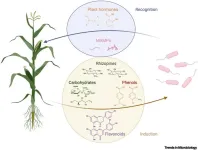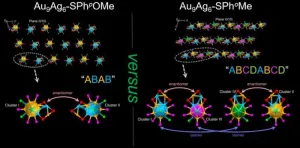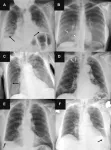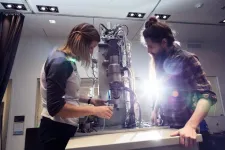(Press-News.org) Nitrogen is an essential nutrient for plant growth, but the overuse of synthetic nitrogen fertilizers in agriculture is not sustainable. In a review article publishing in the journal Trends in Microbiology on September 26, a team of bacteriologists and plant scientists discuss the possibility of using genetic engineering to facilitate mutualistic relationships between plants and nitrogen-fixing microbes called “diazotrophs.” These engineered associations would help crops acquire nitrogen from the air by mimicking the mutualisms between legumes and nitrogen-fixing bacteria.
“Engineering associative diazotrophs to provide nitrogen to crops is a promising and relatively quickly realizable solution to the high cost and sustainability issues associated with synthetic nitrogen fertilizers,” writes the research team, led by senior author Jean-Michel Ané (@JeanMichelAne) of the University of Wisconsin–Madison.
Diazotrophs are species of soil bacteria and archaea that naturally "fix" atmospheric nitrogen into ammonium, a source that plants can use. Some of these microbes have formed mutualistic relationships with plants whereby the plants provide them with a source of carbon and a safe, low-oxygen home, and in return, they supply the plants with nitrogen. For example, legumes house nitrogen-fixing microbes in small nodules on their roots.
However, these mutualisms only occur in a small number of plants and a scant number of crop species. If more plants were able to form associations with nitrogen fixers, it would lessen the need for synthetic nitrogen fertilizers, but these sorts of relationships take eons to evolve naturally.
How to enhance nitrogen fixation in non-legume crops is an ongoing challenge in agriculture. Several different methods have been proposed, including genetically modifying plants so that they themselves produce nitrogenase, the enzyme that nitrogen fixers use to convert atmospheric nitrogen into ammonium, or engineering non-legume plants to produce root nodules.
An alternative method—the topic of this review—would involve engineering both plants and nitrogen-fixing microbes to facilitate mutualistic associations. Essentially, plants would be engineered to be better hosts, and microbes would be engineered to release fixed nitrogen more readily when they encounter molecules that are secreted by the engineered plant hosts.
“Since free-living or associative diazotrophs do not altruistically share their fixed nitrogen with plants, they need to be manipulated to release the fixed nitrogen so the plants can access it,” the authors write.
The approach would rely on bi-directional signaling between plants and microbes, something that already occurs naturally. Microbes have chemoreceptors that allow them to sense metabolites that plants secrete into the soil, while plants are able to sense microbe-associated molecular patterns and microbe-secreted plant hormones. These signaling pathways could be tweaked via genetic engineering to make communication more specific between pairs of engineered plants and microbes.
The authors also discuss ways to make these engineered relationships more efficient. Since nitrogen fixation is an energy-intensive process, it would be useful for microbes to be able to regulate nitrogen fixation and only produce ammonium when necessary. “Relying on signaling from plant-dependent small molecules would ensure that nitrogen is only fixed when the engineered strain is proximal to the desired crop species,” the authors write. “In these systems, cells perform energy-intensive fixation only when most beneficial to the crop.”
Many nitrogen-fixing microbes could provide additional benefits to plants beyond nitrogen fixation, including promoting growth and stress tolerance. The authors say that future research should focus on “stacking” these multiple benefits. However, since these processes are energy-intensive, the researchers suggest developing microbial communities made up of several species that each provide different benefits to “spread the production load among several strains.”
The authors acknowledge that genetic modification is a complex issue, and the large-scale use of genetically modified organisms in agriculture would require public acceptance. “There needs to be transparent communication between scientists, breeders, growers, and consumers about the risks and benefits of these emerging technologies,” the authors write.
There’s also the issue of biocontainment. Because microbes readily exchange genetic material within and between species, measures will be needed to prevent the spread of transgenic material into native microbes in surrounding ecosystems. Several such biocontainment methods have been developed in the laboratory, for example, engineering the microbes so that they are reliant on molecules that are not naturally available, meaning that they will be restricted to the fields in which the engineered host plants are present, or wiring the microbes with “kill switches.” The authors suggest that these control measures might be more effective if they are layered, since each measure has its limitations, and they stress the need to test these engineered plant-microbe mutualisms under the variable field conditions in which crops are grown.
“The practical use of plant-microbe interactions and their laboratory-to-land transition are still challenging due to the high variability of biotic and abiotic environmental factors and their impact on plants, microbes, and their interactions,” the authors write. “Trials in highly controlled environments such as greenhouses often translate poorly to field conditions, and we propose that engineered strains should be tested more readily under highly replicated field trials.”
###
This research was supported by the US Department of Energy.
Trends in Microbiology, Chakraborty et al., “Scripting a new dialogue between diazotrophs and crops” https://cell.com/trends/microbiology/fulltext/S0966-842X(23)00239-1
Trends in Microbiology (@TrendsMicrobiol), published by Cell Press, is a monthly review journal that provides a multidisciplinary forum for the discussion of all aspects of microbiology—from cell biology and immunology to genetics and evolution—and ranges across virology, bacteriology, protozoology, and mycology. Visit http://www.cell.com/trends/microbiology. To receive Cell Press media alerts, please contact press@cell.com.
END
A new study finds that consanguinity – unions between close relatives - may increase the risk of common diseases such as type 2 diabetes and post-traumatic stress disorder (PTSD).
Researchers from the Wellcome Sanger Institute and their collaborators at Queen Mary University of London analysed the genomic data of diverse groups to investigate the relationship between autozygosity - a measure of genetic relatedness between an individual’s parents - and the prevalence of common diseases, with a novel method that reduces confounding due to sociocultural factors. They focused ...
Redefining Global Health Security: A Novel Framework Sheds Light on Equity and Decolonial Approaches
Kuala Lumpur, Malaysia and London, UK – 25 September 2023
In the wake of the COVID-19 pandemic, a new policy paper titled "Global Health Security and the Health-Security Nexus: Principles, Politics and Praxis" in the journal BMJ Global Health, warns of dangers and potential pitfalls associated with the increased attention paid to ‘global health security’ and the growing interaction between public health and security actors.
According to the authors, the prevailing ...
"Of all the subspecies of reindeer found in the high north, the Svalbard reindeer has the most inbreeding and the lowest genetic diversity," says Nicolas Dussex, a postdoc at Norwegian University of Science and Technology´s (NTNU) Department of Natural History.
It was only 7000-8000 years ago that the first reindeer migrated to Svalbard, most likely from Russia via Novaya Zemlya and the islands of Franz Josef Land. Perhaps there were no more than a few animals that established themselves on the arctic ...
HOUSTON – (Sept. 26, 2023) – The Advanced Research Projects Agency for Health (ARPA-H) has awarded $45 million to rapidly develop sense-and-respond implant technology that could slash U.S. cancer-related deaths by more than 50%.
The award to a Rice University-led team of researchers from seven states will fast-track development and testing of a new approach to cancer treatment that aims to dramatically improve immunotherapy outcomes for patients with ovarian, pancreatic and other difficult-to-treat cancers.
“Instead of tethering patients to hospital beds, IV bags and external monitors, ...
Metal nanoclusters are tiny, crystalline structures up to two nanometers (2 x 10-9 meters) in diameter that contain a few to hundreds of metal atoms. Understanding the precise assembly of metal nanoclusters is paramount to determining how different structures affect the properties and molecular interactions of these materials. Researchers recently synthesized two similar gold-silver (Au9Ag6) nanoclusters in a highly controlled manner to determine the precise atomic structure of each nanocluster and the effects of specific thiol ligands, or sulfur-containing binding molecules, on material synthesis.
Given their extremely small size, metal nanoclusters have ...
(Santa Barbara, Calif.) — What makes for a successful climate-resilient fishery, one that sustainably produces resources for human benefit despite increasing climate stressors and human impacts? It’s a question that faces present and future fisheries, their practitioners and fishing communities as the world turns to the ocean to feed its growing population.
“For a fishery to be resilient it needs to be able to prepare for, resist, cope with, recover from, or adapt to any given impact,” said Jacob Eurich, who is a research associate at UC Santa Barbara’s Marine Science Institute, and a fisheries scientist at the Environmental Defense Fund (EDF). “In ...
OAK BROOK, Ill. – In a study of more than 2,000 chest X-rays, radiologists outperformed AI in accurately identifying the presence and absence of three common lung diseases, according to a study published in Radiology, a journal of the Radiological Society of North America (RSNA).
“Chest radiography is a common diagnostic tool, but significant training and experience is required to interpret exams correctly,” said lead researcher Louis L. Plesner, M.D., resident radiologist and Ph.D. fellow in the Department of Radiology at Herlev and Gentofte Hospital in Copenhagen, Denmark.
While commercially available ...
SAN ANTONIO — September 26, 2023—Researchers from Southwest Research Institute (SwRI) and The University of Texas at San Antonio (UTSA) are developing techniques to detect traumatic brain injury (TBI) by analyzing breath for specific biomarkers. The project, led by SwRI’s Dr. Mark Libardoni and UTSA’s Dr. Marzieh Memar and Dr. Morteza Seidi, is supported by a $125,000 grant from the Connecting through Research Partnerships (Connect) program.
Breath analysis is performed by analyzing exhaled breath for specific biomarkers, such as metabolites, proteins and ...
A complete map of all the connections in an entire mammalian brain may be in sight. Allen Institute researchers have just launched three new projects to construct large, detailed maps of neuronal connections in sections of the mouse and macaque brains, with an eye toward creating full wiring diagrams of these animals’ brains in the future. These projects are funded by the National Institutes of Health’s Brain Research Through Advancing Innovative Neurotechnologies® (BRAIN) Initiative.
Allen Institute research teams ...
The MIT Press is delighted to announce that it has received a two-year, $275,000 Early-Concept Grant for Exploratory Research (EAGER) from the National Science Foundation to expand the shift+OPEN initiative and shift at least two more journals to diamond open access. The Press will also use the grant to assess and compare the viability of open access models for advancing and sustaining the outputs of scientific and scholarly STEM and HSS research.
“We’re grateful to the National Science Foundation for their support of our growing shift+OPEN program,” says Nick Lindsay, Director for Journals and Open Access for the MIT ...







